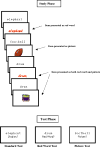Diagnostic retrieval monitoring in patients with frontal lobe lesions: further exploration of the distinctiveness heuristic
- PMID: 17485102
- PMCID: PMC3407562
- DOI: 10.1016/j.neuropsychologia.2007.03.018
Diagnostic retrieval monitoring in patients with frontal lobe lesions: further exploration of the distinctiveness heuristic
Abstract
The distinctiveness heuristic is a diagnostic monitoring strategy whereby a subject expects a vivid recollection if a test item has been seen during the study session; the absence of a vivid recollection suggests the test item is novel. Consistent with the hypothesis that memory monitoring is dependent upon the frontal lobes, previous work using a repetition-lag paradigm found that patients with frontal lobe lesions were unable to use the distinctiveness heuristic. Evidence from recent neuroimaging studies, however, has suggested that use of the distinctiveness heuristic decreases the need for frontal processing. The present study used the criterial recollection task to revisit the question of whether patients with frontal lobe lesions are able to use a distinctiveness heuristic. Subjects studied black words paired with the same word in red font, a corresponding picture of the word, or both. They then took three memory tests designed to elicit false recognition of presented items. Both frontal lesion patients and matched control subjects showed intact ability to use the distinctiveness heuristic to reduce false recognition when tested on whether items were previously presented as pictures compared to red words. This use of the distinctiveness heuristic is evidence that patients with frontal lesions can use certain diagnostic monitoring strategies during recognition memory tasks when given guidance in coordinating their decision-making processes. This result suggests that the frontal lobes are necessary for self-initiation of this strategy during recognition memory tasks.
Figures


Similar articles
-
Metacognition and false recognition in patients with frontal lobe lesions: the distinctiveness heuristic.Neuropsychologia. 2005;43(6):860-71. doi: 10.1016/j.neuropsychologia.2004.09.011. Neuropsychologia. 2005. PMID: 15716158 Clinical Trial.
-
Prefrontal activity and diagnostic monitoring of memory retrieval: FMRI of the criterial recollection task.J Cogn Neurosci. 2006 Jan;18(1):135-48. doi: 10.1162/089892906775250049. J Cogn Neurosci. 2006. PMID: 16417689 Clinical Trial.
-
Variability in the impairment of recognition memory in patients with frontal lobe lesions.Cortex. 2006 Oct;42(7):983-94. doi: 10.1016/s0010-9452(08)70204-1. Cortex. 2006. PMID: 17172178
-
The frontal lobes and traumatic brain injury.J Neuropsychiatry Clin Neurosci. 1994 Fall;6(4):443-54. doi: 10.1176/jnp.6.4.443. J Neuropsychiatry Clin Neurosci. 1994. PMID: 7841815 Review.
-
[Source monitoring: general presentation and review of literature in schizophrenia].Encephale. 2010 Sep;36(4):326-33. doi: 10.1016/j.encep.2009.12.010. Epub 2010 Mar 7. Encephale. 2010. PMID: 20850604 Review. French.
Cited by
-
Richer concepts are better remembered: number of features effects in free recall.Front Hum Neurosci. 2012 Apr 3;6:73. doi: 10.3389/fnhum.2012.00073. eCollection 2012. Front Hum Neurosci. 2012. PMID: 22514526 Free PMC article.
-
The medial temporal lobe-conduit of parallel connectivity: a model for attention, memory, and perception.Front Integr Neurosci. 2014 Nov 11;8:86. doi: 10.3389/fnint.2014.00086. eCollection 2014. Front Integr Neurosci. 2014. PMID: 25426036 Free PMC article.
-
Response bias and response monitoring: Evidence from healthy older adults and patients with mild Alzheimer's disease.Brain Cogn. 2017 Dec;119:17-24. doi: 10.1016/j.bandc.2017.09.002. Epub 2017 Sep 17. Brain Cogn. 2017. PMID: 28926752 Free PMC article.
-
False memories in patients with mild cognitive impairment and mild Alzheimer's disease dementia: Can cognitive strategies help?J Clin Exp Neuropsychol. 2019 Mar;41(2):204-218. doi: 10.1080/13803395.2018.1513453. Epub 2018 Sep 4. J Clin Exp Neuropsychol. 2019. PMID: 30179518 Free PMC article.
-
Age-related differences in prefrontal cortex activity during retrieval monitoring: testing the compensation and dysfunction accounts.Cereb Cortex. 2013 May;23(5):1049-60. doi: 10.1093/cercor/bhs064. Epub 2012 Apr 17. Cereb Cortex. 2013. PMID: 22510532 Free PMC article.
References
-
- Adjutant General's Office. The trail making test. War Department, U. S. Army; 1944.
-
- Anderson RE. Did i do it or did i only imagine doing it? Journal of Experimental Psychology: General. 1984;113:594–613.
-
- Bechara A, Van Der Linden M. Decision-making and impulse control after frontal lobe injuries. Current Opinion in Neurology. 2005;18:734–739. - PubMed
-
- Berman KF, Ostrem JL, Randolph C, Gold J, Goldberg TE, Coppola R, et al. Physiological activation of a cortical network during performance of the wisconsin card sorting test: A positron emission tomography study. Neuropsychologia. 1995;33:1027–1046. - PubMed
Publication types
MeSH terms
Grants and funding
LinkOut - more resources
Full Text Sources

